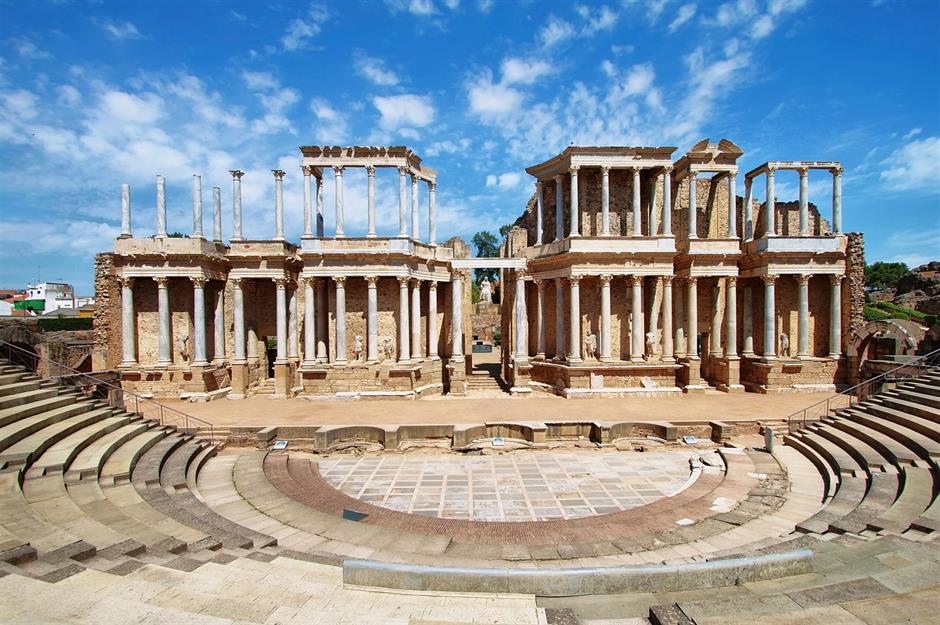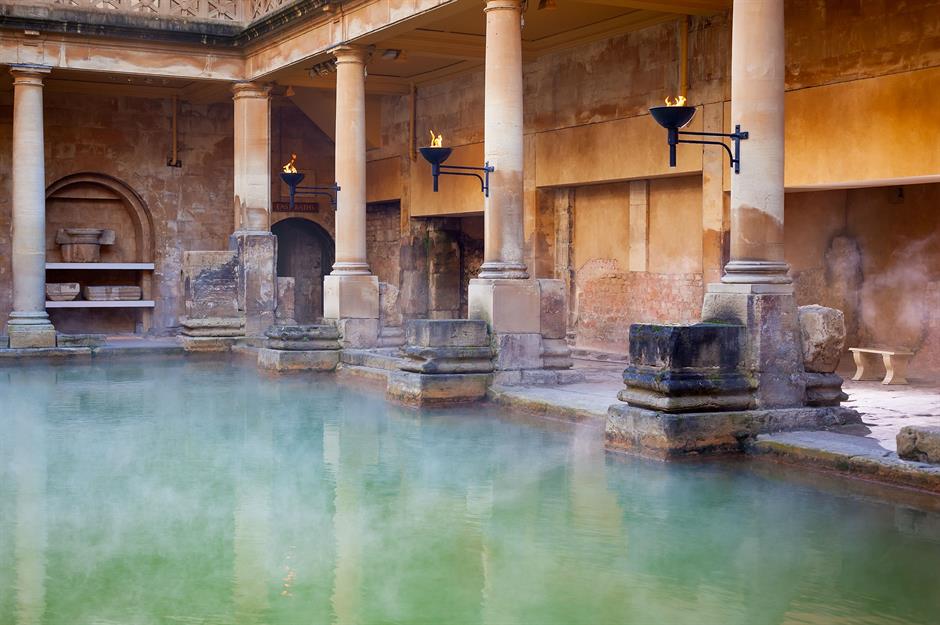Fabulous photos of fascinating Roman ruins around the world
Wonders of the ancient world
Roman Baths, Bath, England, UK
The city of Bath, known as Aquae Sulis in ancient times, is home to some of the best-preserved Roman baths in Europe. Bathing played a significant part in the ancient Roman culture and society and cities that centred around hot springs – like Bath or Vichy in France and Aachen in Germany – essentially became holiday destinations for wealthy Romans.
Roman Baths, Bath, England, UK
While you can't take a dip in the Great Bath itself – still supplied by the city's natural thermal hot springs – normally you'd be able to experience the local waters in the modern-day setting of the Thermae Bath Spa, just around the corner. The Roman Baths museum is also fascinating as it houses several significant discoveries, including the bronze-sculpted head of Roman goddess Sulis Minerva, the primary deity of the temple spa.
Pont du Gard, Occitanie, France
The nearly 2,000-year-old Pont du Gard aqueduct bridge is an incredible reminder of the ingenuity of Roman engineering. Built to supply water to the nearby city of Nîmes, it's the highest and one of the best-preserved Roman bridges still standing. Crossing the picturesque Gardon River, the bridge consists of three tiers of arches at a total height of around 160 feet (49m) and the aqueduct was still used as late as the 6th century.
Pompeii, Campania, Italy
Pompeii’s eerie remains still hide in the shadow of Mount Vesuvius – the volcano that destroyed the city in AD 79 in one of history's deadliest eruptions. Much of the city was preserved under a thick layer of volcanic ash and wasn't rediscovered until the 16th century. In fact, many of its secrets have only just been uncovered.
Pompeii, Campania, Italy
Pompeii, Campania, Italy
Pompeii, Campania, Italy
One of the most interesting discoveries has been the uncovering of the ancient graffiti bearing political slogans, remarks and simply: "Gaius Pumidius Diphilus was here". The grafitti found in the city has provided a wealth of examples of Vulgar Latin – a language spoken colloquially at the time in contrast to the former language of classical writers. Inscriptions include declarations of love, political messages and a few good insults.
Herculaneum, Campania, Italy
Herculaneum, Campania, Italy
Herculaneum, Campania, Italy
Hadrian's Wall, England, UK
Hadrian’s Wall was built as a line of defence by the Romans to protect against northern barbarian tribes, and ran from the west to the east coast of Britain. Crossing the country from Wallsend on the River Tyne to Bowness-on-Solway, the wall is one of the most famous frontiers of the Roman Empire. The construction started in AD 122 and took six years and 15,000 men to complete.
Hadrian's Wall, England, UK
Hadrian's Wall, England, UK
It was actually one of the more luxurious postings in all of the empire, too, as the forts along the wall had flushing toilets and some had access to a hypocaust – an underfloor heating system. It also continues to have an impact on modern-day life as writers including George R. R. Martin are said to have been inspired by the wall. Now discover the secrets of the world's most amazing walls.
Butrint, Albania
Butrint, Albania
Butrint, Albania
Cartagena, Spain
Pantheon, Rome, Italy
It will come as no surprise that Rome has the largest wealth of ancient Roman ruins in the world. Once the centre of the sprawling empire, Rome has a history that's evident with every step. One of the city's most famous landmarks, the Pantheon, was formerly a Roman temple and is now a Christian church. Although the current building was finished as early as AD 125, it remains one of the best preserved.
Pantheon, Rome, Italy
Inside, at the centre of the dome – still the largest unreinforced concrete dome in the world – you'll find the oculus, a circular hole that's the main source of light. Despite its ancient beginnings, the Pantheon has influenced some incredible Western architecture, inspiring Brunelleschi's ground-breaking dome of Santa Maria del Fiore in Florence and the US State Capitol dome in Washington DC.
Appian Way, Rome, Italy
Appian Way, Rome, Italy
Ostia Antica, Ostia, Italy
Ostia Antica, Ostia, Italy
Colosseum, Rome, Italy
Perhaps the most famous of all the Roman ruins in the world, the Colosseum is the largest amphitheatre ever built. It took around eight years to construct and it was intended as a gift to the Roman people from emperor Vespasian, who ruled from AD 69 to 79. In its heyday, the Colosseum could hold up to 80,000 spectators.
Colosseum, Rome, Italy
Colosseum, Rome, Italy
Although hugely impressive, the Colosseum is a reminder of the brutality of Roman society, culture and entertainment. It's estimated around 60,000 slaves participated in building this monumental structure and an estimated 400,000 people died in the Colosseum either in executions or as gladiators. Throughout its time in operation, around 1,000,000 animals, especially creatures from far-flung reaches of the world like leopards, crocodiles and elephants, fell victim to the brutal Romans too.
Roman Forum, Rome, Italy
One of the most significant Roman ruins, the Roman Forum was once the centre of the government. A rectangular plaza surrounded by several ancient government buildings, this is where elections, criminal trials and most of the empire's political life took place for centuries. Some of the Roman kingdom's earliest shrines, like the formal residence Regia, date as far back as the 8th century BC – well before the empire.
Roman Forum, Rome, Italy
Among the surviving ruins, the Temple of Saturn (pictured) was one of the most significant buildings in the Forum. Originally a temple dedicated to Jupiter (who was later replaced by Saturn), it was also a central bank used by all Roman people. Other significant structures include the well-preserved Temple of Antoninus and Faustina, the Arch of Septimius Severus and the Arch of Titus.
Arch of Constantine, Rome, Italy
Finally, a visit to the Colosseum and the Forum isn't complete without the Arch of Constantine nearby. Built in celebration of emperor Constantine the Great's victory over Maxentius at the Battle of Milvian Bridge in AD 312, it's considered one of the last great monuments of Imperial Rome, standing at 69 feet (21m) tall.
Mérida, Spain
Founded in 25 BC, Mérida in western Spain was known to the Romans as Augusta Emerita and was one of the biggest Roman cities here. Today Mérida is proud to have the largest collection of Roman ruins you'll find in Spain, with spectacular UNESCO World Heritage Sites like the Temple of Diana (pictured). Dedicated to the goddess Roma and Emperor Augustus, the temple dates back to the 1st century BC and was part of the city's forum.
Mérida, Spain
Stretching across the Guadiana River, Mérida's Puente Romano (Spanish for Roman bridge) is another incredible Roman landmark. It's the world's longest remaining Roman bridge, spanning 2,365 feet (721m) with 60 surviving half-moon arches and is almost 2,000 years old. Today, it's a pedestrian bridge, offering gorgeous views of the adjacent Moorish fortification Alcazaba of Mérida, built in 835.
Mérida, Spain
The theatre of Mérida, constructed in 15 BC, is still as impressive as it was back in the day when it served as the city's centre of leisure, fun and savage Roman entertainment. With seats for 6,000 spectators, the venue hosted all sorts of spectacles, from animal fights and battle re-enactments to gruesome events like gladiator contests and executions. Still in use today, the theatre hosts a much more civil Classical Theatre Festival every summer, featuring opera and plays.
Now discover little-known Roman ruins around the world

